JE29: Electrostatic shocks: kinetic and fluid¶
Introduction¶
In this notes I compare results from 1D/1V simulations of electrostatic shocks with those obtained from the multi-fluid, 5-moment model. The Poisson-bracket formulation of Vlasov-Poisson equations is used. See JE15 for formulation of the equations, and basic benchmarks.
The basic setup for all problems is the same: two counter propagating beams of plasmas start interacting at \(t=0\). The beams have initial drift speed determined from their Mach number, \(M \equiv u/c_s\), where \(u\) is the drift velocity, and \(c_s \equiv \sqrt{T_e/m_i}\) is the sound speed. The domain size is \(500\) Debye lengths, with time measured in inverse plasma frequency \(1/\omega_{pe}\). For all problems, a DG/CG scheme with polynomial order 2 is used.
The multi-fluid simulations are setup in an identical way. However, the full Maxwell equations are evolved instead of the Poisson equation. A finite-volume scheme is used to solve the multi-fluid equations. For benchmarks of the FV scheme, see JE4 and other notes following that.
Note that for these problem the domain size, and hence the run-time, can be reduced by a 2X by using reflecting boundaries instead of two counter propagating beams. However, as of this writing, Gkeyll does not have reflecting BCs for the distribution function, and hence I am just using a bigger domain.
Some notes on collisionless electrostatic shock formation¶
When two counter propagating, but otherwise identical, slabs of plasma collide, a potential well is created, leading to trapping of electrons and the formation of shocks from nonlinear steepening of wave fronts. However, this shock formation only happens to a critical Mach number of about \(M_c = 3\) [1]. The situation is different. however, when the plasma slabs have different temperatures and/or densities. In this case [2] any Mach number shock can be obtained, as long as the correct temperature and densities ratios are selected. The critical Mach number (above which an collisionless ES shock is not formed) is given by
where \(Y = n_R/n_L\) and \(\Theta = T_{eR}/T_{eL}\) are the density and electron temperature ratios (ions assumed to be cold) of the slabs, respectively.
The potential well, besides trapping electrons, reflects ions back into the oncoming plasma and decelerates the ions in the interaction region. For higher Mach numbers (above the critical Mach number) there isn’t enough slowing down of the ions to create a shock, and the trapped particle region keeps growing with time (instead of nonlinear steepening leading to shock formation). For colder ions there are significant amplitude ion waves, which damp out in the warmer ion case.
In the following simulations, I use various mass ratios and electron/ion temperature ratios to simulate the formation of collisionless ES shocks. In addition, I compare the results with fluid simulations with identical parameters. Fluid models will always show shock formation, independent of the Mach number. However, the mechanism of shock formation is different (than in the kinetic case) and is a combination of charge separation and collisions (which keep the plasma Maxwellian). At some point it will be useful to perform simulations with some collision operator.
Hydrogen plasma, \(T_e/T_i = 9.0\). Kinetic simulations¶
In this sequence of simulations, I use a hydrogen plasma, \(m_e/m_i = 1/1836.2\), with \(T_e/T_i = 9.0\). I run simulations with initial Mach numbers of \(1.5\) [m1], \(3.0\) [m3] and \(5.0\) [m4].
The distribution functions for the Mach \(1.5\) and Mach \(5.0\) at \(T\Omega_{pe} = 1000\) are shown below.
In the first case, the potential well traps the electrons and decelerates the ions in the interaction region, significantly slowing them down. The trapped electron component flattens the electron distribution function (leading to a “flat-top” distribution). The reflected ions seem to undergo some oscillations, which are, however, damped. The evolution is markedly different in the Mach \(5.0\) case. The ion momentum is so high that the potential well is unable to slow down the ions in the interaction region, and the reflected ions also have a very small increase in velocity. However, in each case, in the interaction region the electron distribution function takes a characteristic flat-top shape, as shown below.
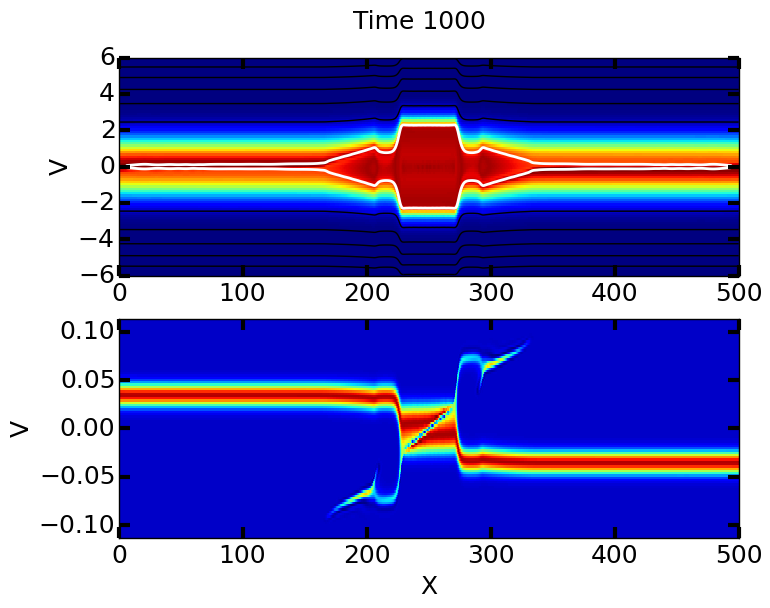
Electron (upper) and ion (lower) distribution function at \(T\Omega_{pe}=1000\) for Mach \(1.5\) case. Note the steepening of wave fronts leading to shock formation. The ions in the interaction region have slowed down significantly, and the reflected ions show oscillations. On the electron distribution function is also superimposed in white the contour of zero Hamiltonian (i.e the contour \(m_e v^2/2 - e \phi = 0\)). Inside this region, the electrons are trapped, leading to formation of a flat-top distribution function.¶
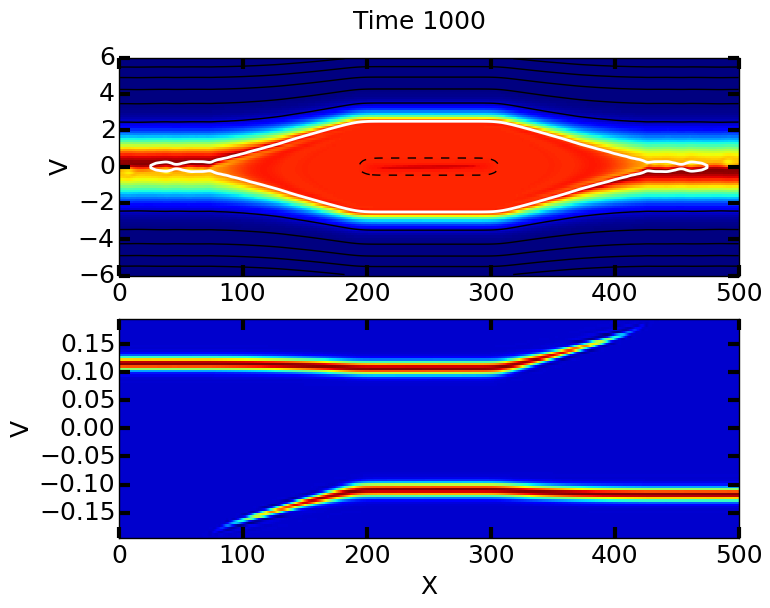
Electron (upper) and ion (lower) distribution function at \(T\Omega_{pe}=1000\) for Mach \(5.0\) case. In contrast to the Mach \(1.5\) case, there is no nonlinear steepening and shock formation. Also, the potential well does not slow down the ions in the interaction region significantly. On the electron distribution function is also superimposed in white the contour of zero Hamiltonian (i.e the contour \(m_e v^2/2 - e \phi = 0\)). Inside this region, the electrons are trapped, leading to formation of a flat-top distribution function.¶
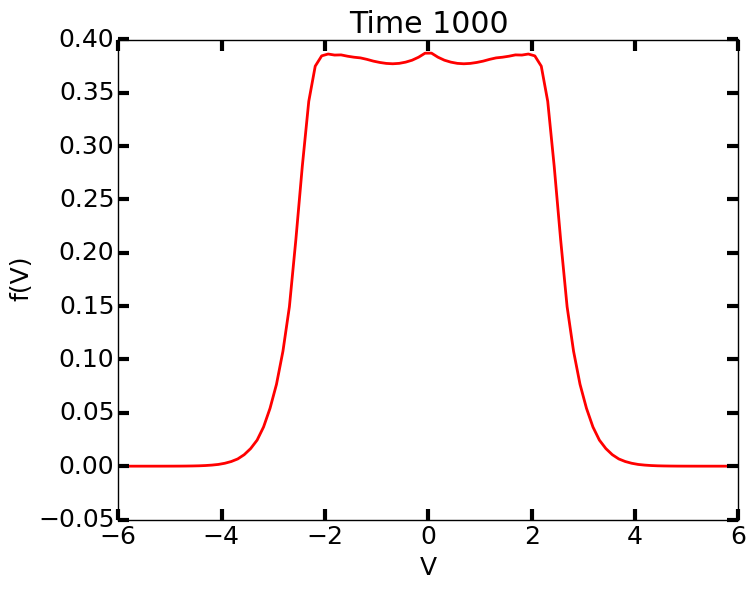
Cross-section of the electron distribution function in the center of the domain at \(T\Omega_{pe}=1000\) for Mach \(1.5\) case. Particle trapping has led to formation of a typical flat-top distribution function. The shape of the distribution function inside the interaction region remains nearly constant in time.¶
Hydrogen plasma, \(T_e/T_i = 9.0\). Comparison with fluids¶
I ran a set of two-fluid simulations (electrons and ions treated as separate fluids coupled via electromagnetic source terms, the field evolved with Maxwell equations) with the same parameters and initial conditions as used for the kinetic simulations. In general, the fluid results compare well (except for ion energy) with kinetic results for low Mach numbers. The ion energy outside the interaction region in the kinetic simulations is dominated by the high-energy reflected ions, leading to significant differences with the fluid results.
However, for higher Mach numbers the results are dramatically different. The fluid simulations always show a shock, independent of Mach number. The trapped particle effects are not captured in the fluid model, and collisions (missing in the kinetic model) force the distribution functions to be Maxwellian. Hence, the kinetic effects, which lead to the nonlinear physics (particle trapping and ion deceleration) in the interaction regions, are not correctly captured in the interaction region.
In the following plots, the kinetic and fluid results for density, momentum density (\(n u\)) and energy density (\(n u^2 + nv_{th}^2\)) are compared.
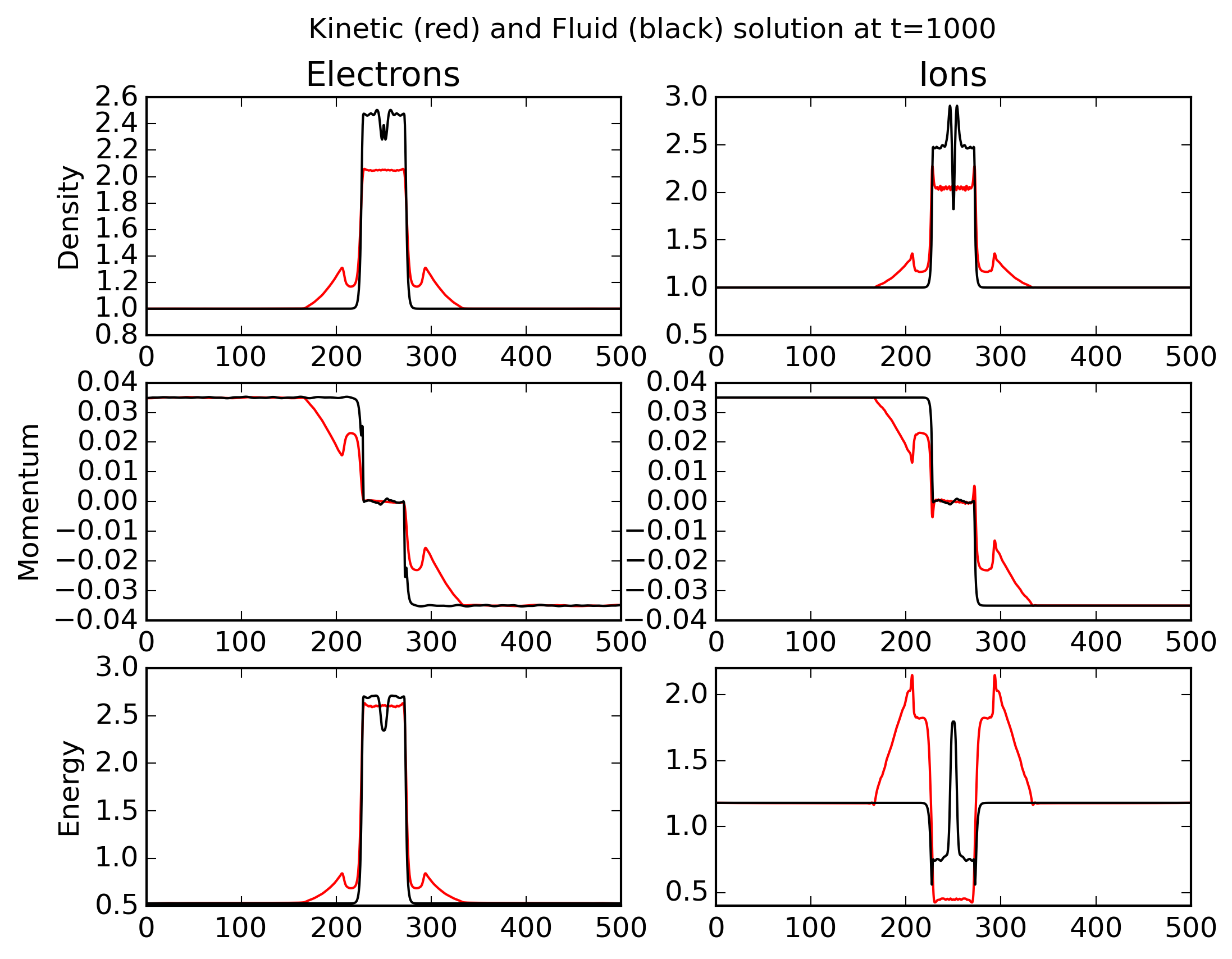
Comparison of fluid (black) and kinetic (red) results for electrons (left column) and ions (right column) for density (top), momentum density (middle) and energy density (bottom) for Mach \(1.5\) case. The fluid model correctly predicts the shock location. The values of the density are lower in the kinetic simulations due to flat-top distribution. The ion energy is significantly different as the fluid model is unable to capture the effect of the reflected ions, making up the high-energy tails outside the interaction region.¶
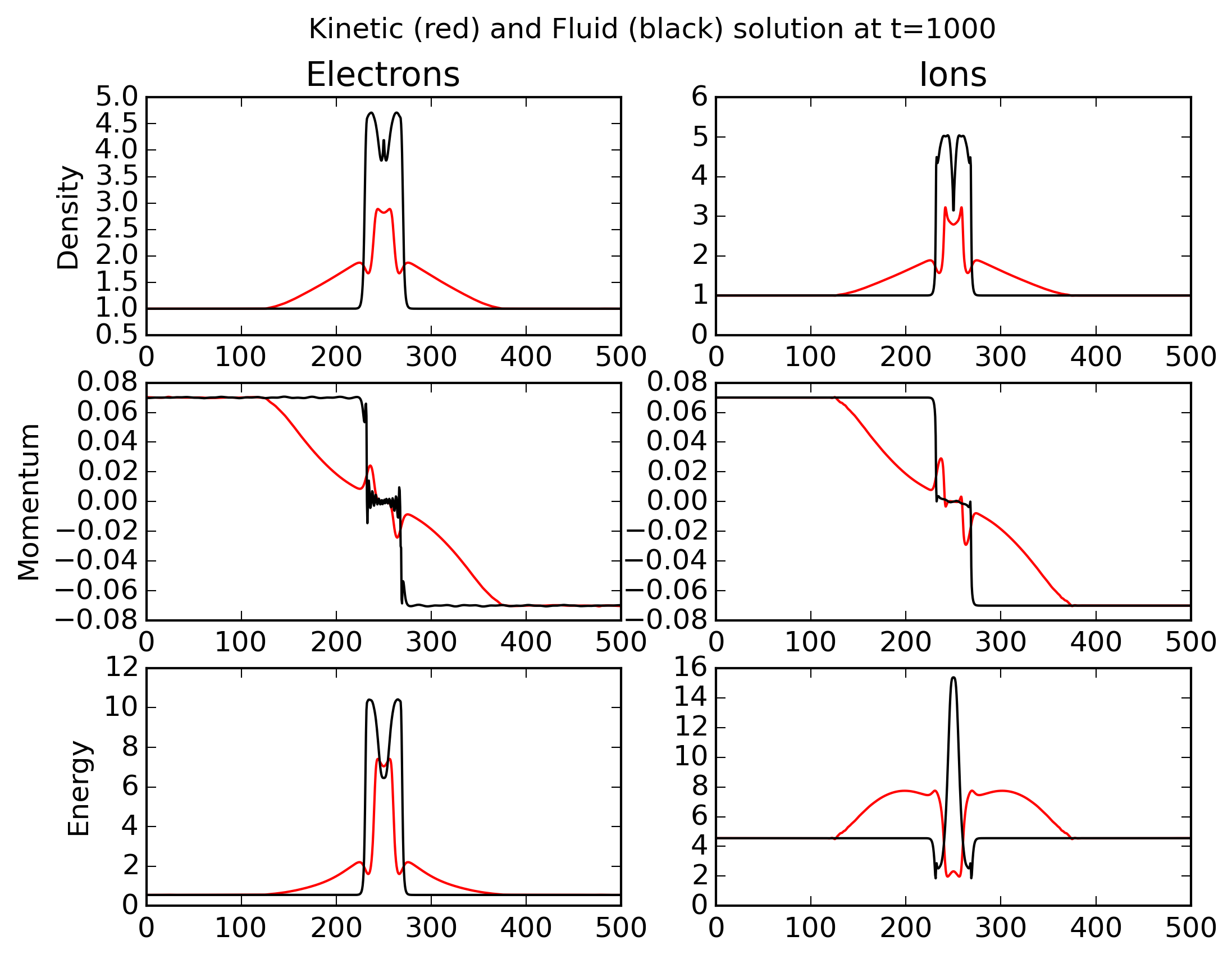
Same as previous figure, except for for Mach \(3.0\) case. The fluid model now shows significant differences from the kinetic results. The nearly linear drop of moments (compared to the step-function like shock profiles for lower Mach numbers) leads to more diffuse profiles in the kinetic case.¶
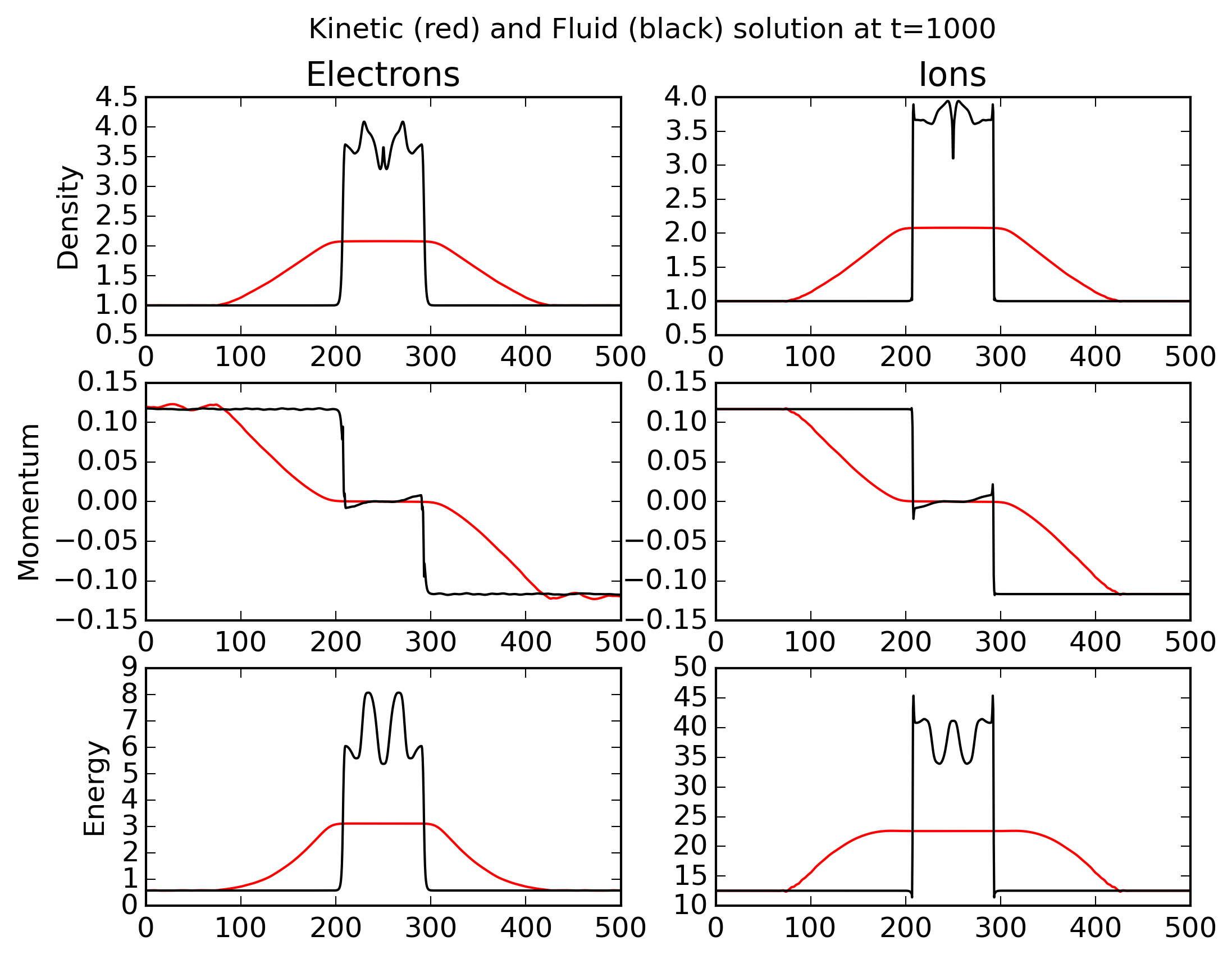
Same as previous figures, except for for Mach \(5.0\) case. The lack of shock in the kinetic solutions leads to significant differences with the fluid results.¶
Conclusions¶
Kinetic simulations of collisionless electrostatic shocks confirm the lack of shocks above the critical Mach number. Comparisons with multi-fluid simulations show that the fluid model correctly predicts the shock location and profiles of moments (except for ion energy density) for low Mach number cases. However, the fluid results diverge significantly for high Mach numbers: shocks don’t form above a critical Mach number in the kinetic model, while continue to form in the fluid model. This indicate some caution in using fluid approximations to model collisionless shocks.
